The Blue Whale, Balaenoptera musculus, is the largest mammal on earth, measuring up to 34 m and weighing up to 150 tons. There are 600 – 1500 Blue Whales in the North Atlantic with pollution, climate change, lack of food and boat collisions being the main threats to this endangered species.
Tragically, one of these blue whales was spotted dead on May 2nd floating off the coast of Liverpool, Nova Scotia. It is believed to be the same whale observed dead in March off the coast of Newfoundland. While dead whales are an important source of biological information, determining cause of death for any endangered species is often a priority. This case was no exception. To facilitate a necropsy (autopsy of a dead animal), and collect samples for later research, the 18 m juvenile female whale was towed to a beach where researchers had easy access.
The necropsy, directed by Andrew Reid of the Marine Animal Rescue Society (MARS) and veterinarians Drs. Pierre-Yves Daoust, Atlantic Veterinary College (AVC), and Chris Harvey-Clark, Dalhousie University, involved various collaborators. Among the latter was the New Brunswick Museum. On May 11th, Mary Sollows, NBM Curatorial Technician in Zoology, and Madelaine Empey, Student Zoology Assistant, travelled to Liverpool to join the necropsy team. Working against tides and time, they joined veterinary students from the AVC, marine biology students from Dalhousie University, associates from MARS and the Oceanographic Environmental Research Society (OERS), and employees of the Department of Fisheries and Oceans (DFO).The goal was to try and determine how the whale died and, for Mary and Madelaine, to collect samples for addition to the NBM marine mammal research collection, one of the largest in Canada.
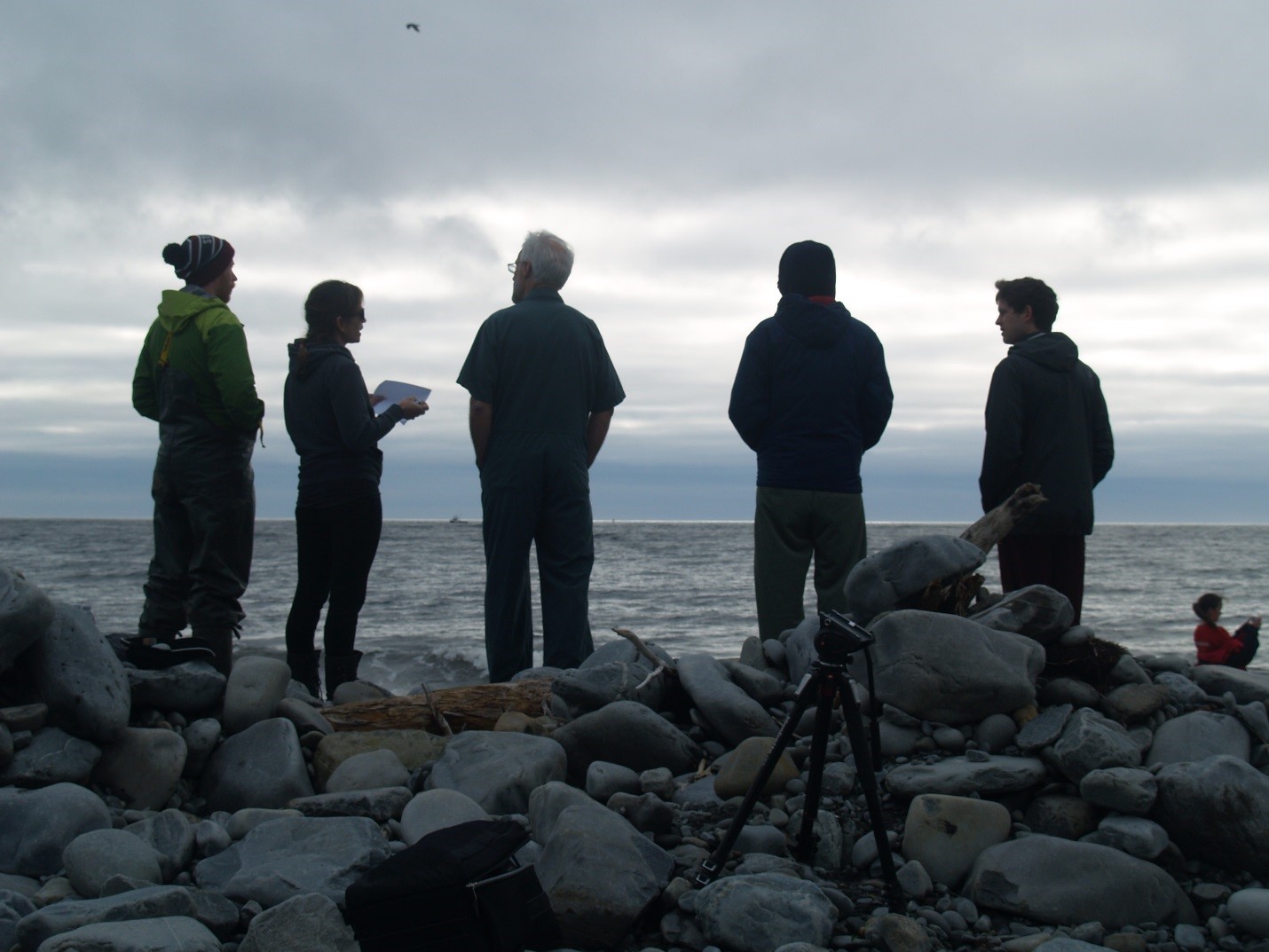 Tonya Wimmer (second from left) Marine Animal Rescue Society, discussing necropsy with Dr. Pierre-Yves Daoust (third from left), Atlantic Veterinary College.
Tonya Wimmer (second from left) Marine Animal Rescue Society, discussing necropsy with Dr. Pierre-Yves Daoust (third from left), Atlantic Veterinary College.
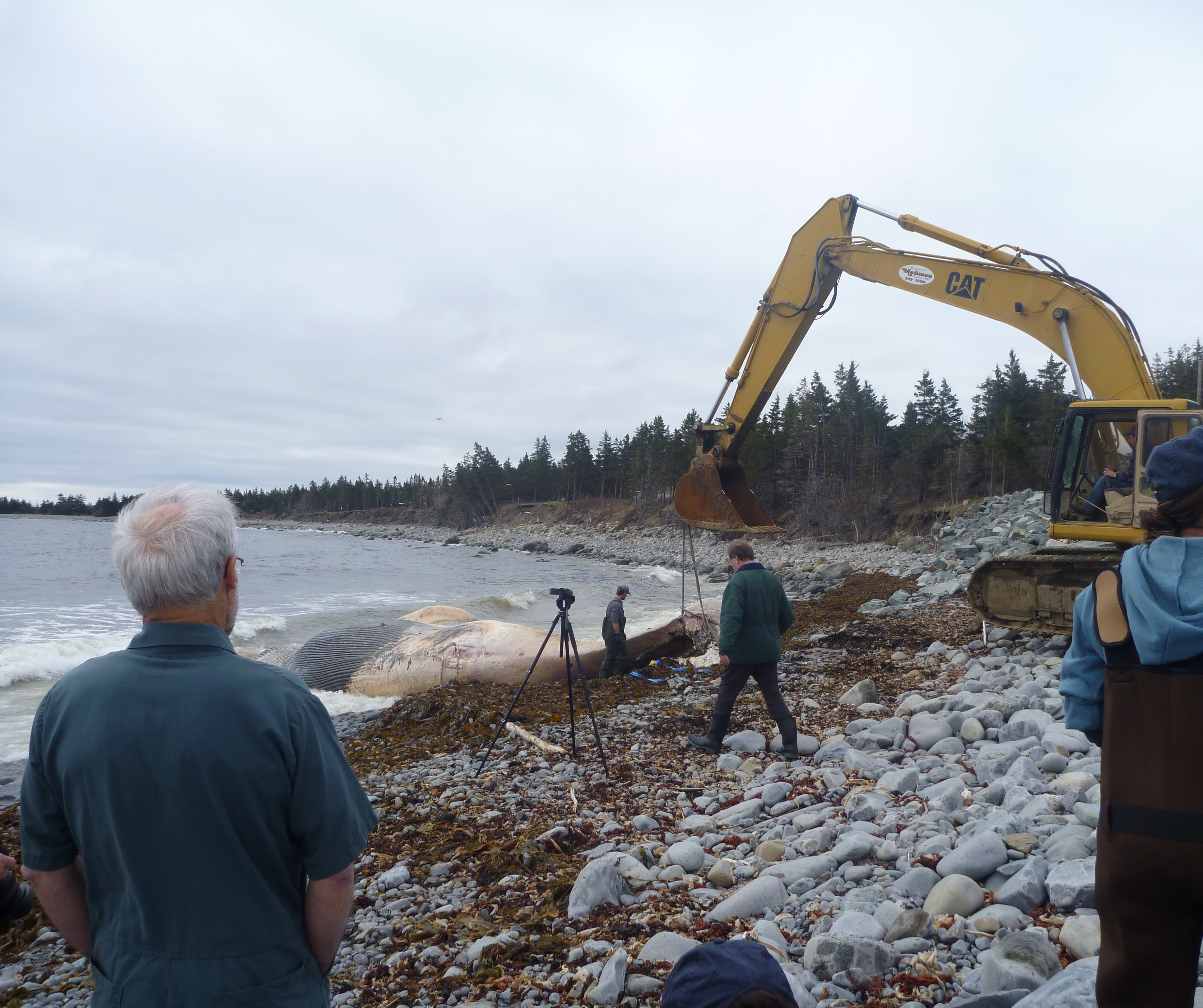 Dr. Pierre-Yves Daoust, Andrew Reid and Dr. Chris Harvey-Clark survey the Blue Whale prior to the necropsy.
Dr. Pierre-Yves Daoust, Andrew Reid and Dr. Chris Harvey-Clark survey the Blue Whale prior to the necropsy.
Conducting a necropsy on an animal that weighs many tons requires lots of people, but also demands the use of heavy equipment, including an excavator, dump trucks, and industrial cables. It is also a costly process that in this case was funded by the federal Department of Fisheries and Oceans, who have legal responsibility for the management of marine mammals in Canadian waters. On the first day of the necropsy the whale was lying on its right side with its head to the water and tail shoreward. Typically, large whales are flensed (the term used for butchering a whale) in much the same way a banana is peeled. Length-wise cuts are made from the head back to the tail, a hole is cut in the blubber, a strap or cable inserted and attached to the excavator, and the blubber peeled back in sections under tension. The work, messy and stinky, requires two attributes of those involved- a strong dose of zoological curiosity and a weak sense of smell! There were two jobs for those not directly involved in assessing the cause of death: cutting the muscle and sinew from the whale skeleton, and hooking the tissue that was removed and placing it in the backhoe of the excavator for disposal. Periodically, the excavator would place the tissue in a garbage truck for transport to a composting facility in Truro, Nova Scotia.
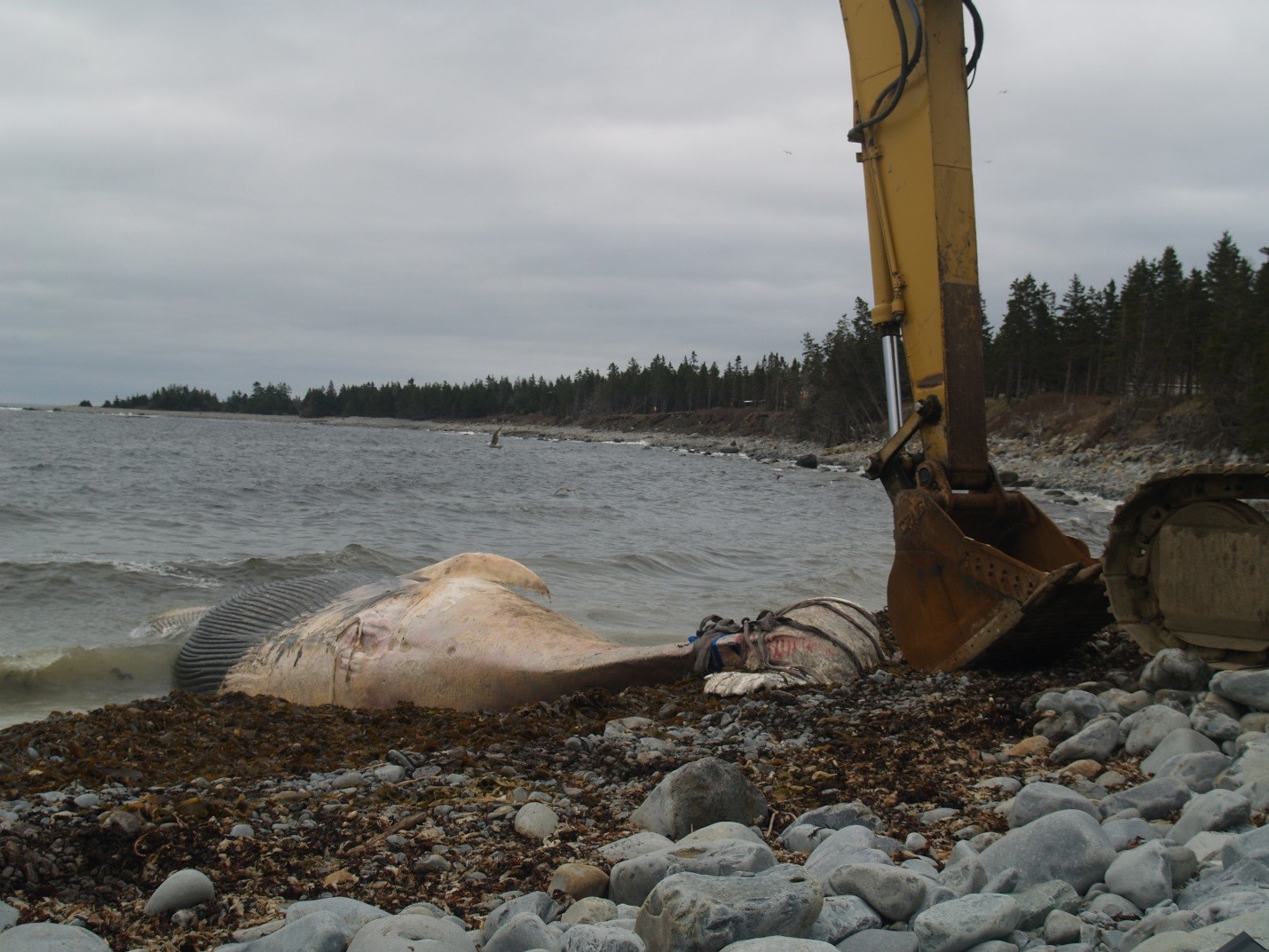 Ventral view of the Blue Whale, the head towards the water and the tail in front of the excavator.
Ventral view of the Blue Whale, the head towards the water and the tail in front of the excavator.
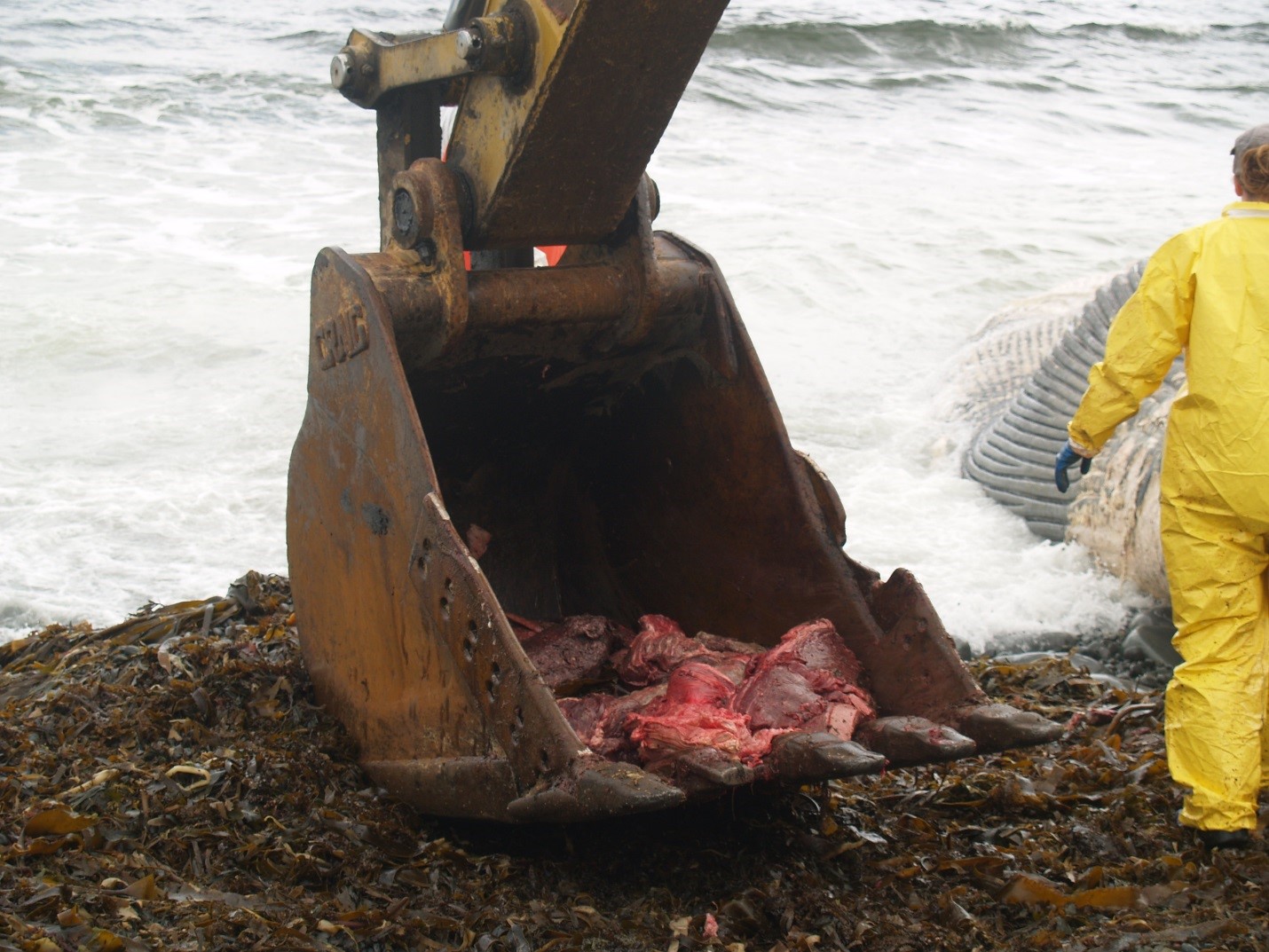 Blue Whale muscle and sinew was placed in the excavator backhoe prior to disposal.
Blue Whale muscle and sinew was placed in the excavator backhoe prior to disposal.
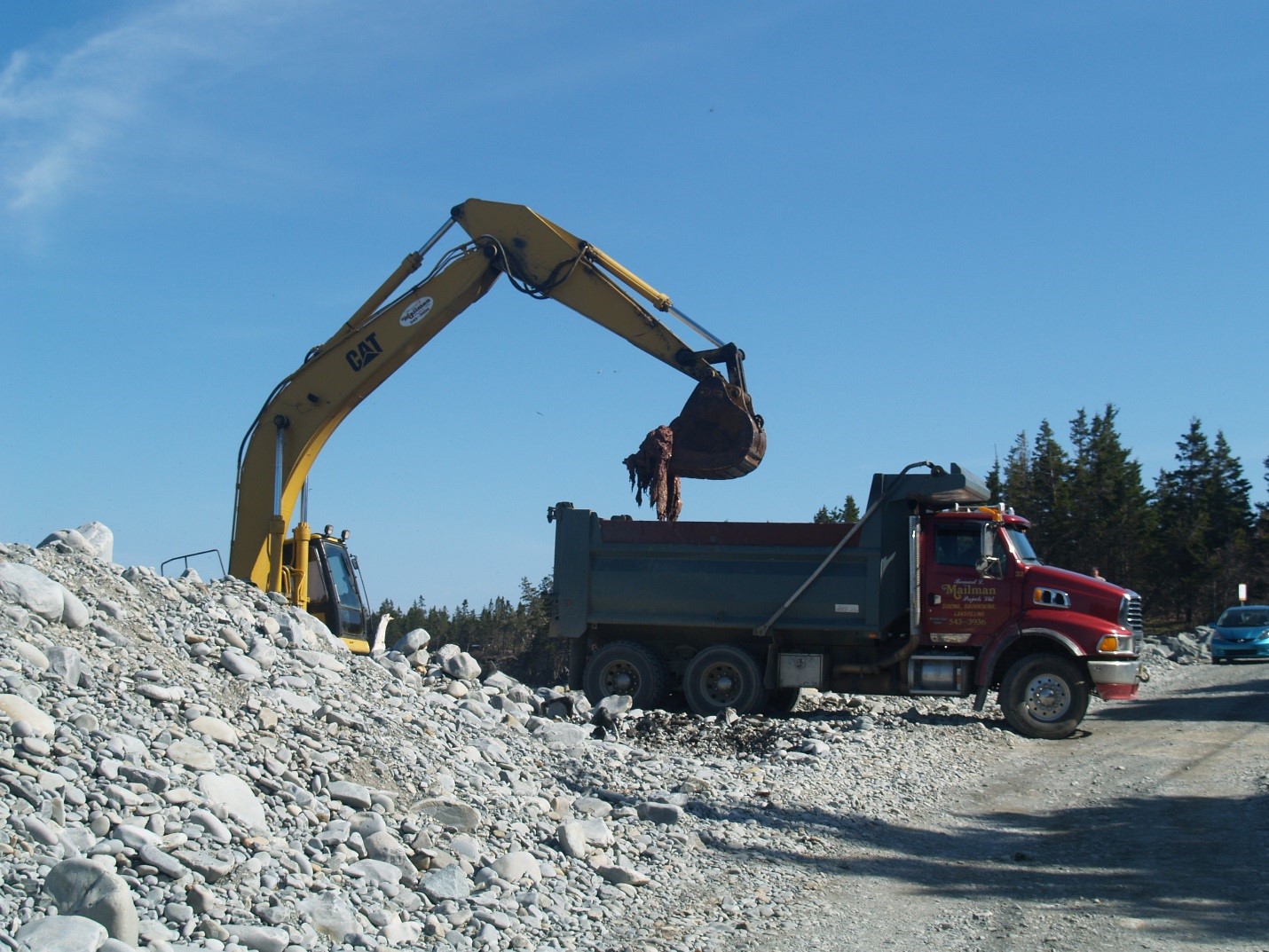 Discarded Blue Whale tissue was transported by dump truck to Truro, Nova Scotia, for composting.
Discarded Blue Whale tissue was transported by dump truck to Truro, Nova Scotia, for composting.
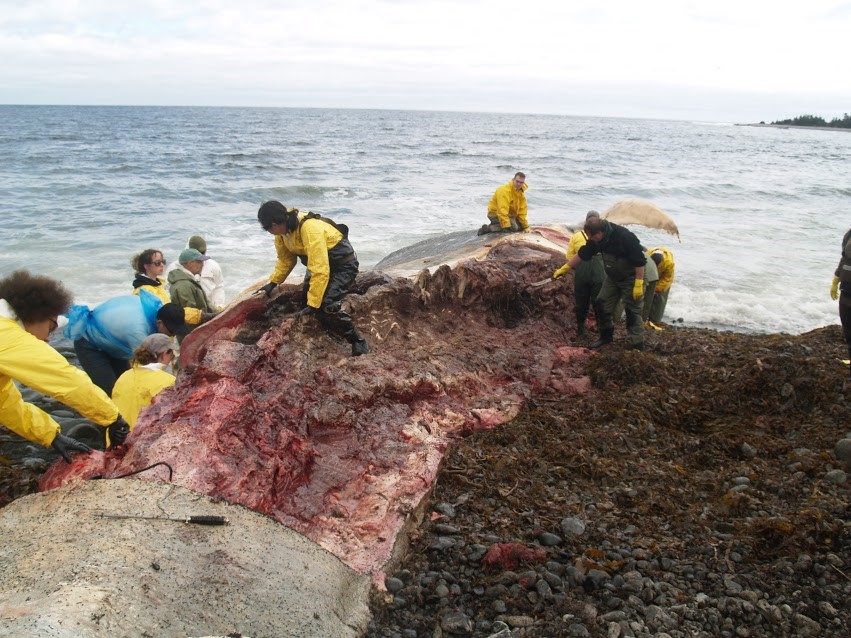 Students and volunteers spend three days undertaking a necropsy and de-fleshing the skeleton of the Blue Whale.
Students and volunteers spend three days undertaking a necropsy and de-fleshing the skeleton of the Blue Whale.
A large blood clot was found among the thoracic vertebrae associated with two fractured vertebral processes. Veterinarians were not certain this was correlated with the death of the whale, but this injury and numerous other notes and measurements were added to the necropsy report. There have been suggestions that the whale may have become trapped under ice and drowned. However, it may be some months before a conclusion on cause of death can be reached, and given the advanced state of decomposition, a definitive answer may never be known.
On the morning of the second day, volunteers arrived to find that the tide had moved the whale overnight and that it was lying parallel to the shore, its back facing the water. The swell, constantly pounding the body, had broken some of the bones and swept others away. The beach was searched for any of the missing skeletal elements, in particular because Dr. Harvey-Clarke plans to assemble the full skeleton. When the morning tide receded, the tail was cut away from the body and moved by excavator to a location higher on the beach. Half of the team then worked on the body of the whale and the other on the tail section. Mary Sollows, joined by her husband, Ken Sollows (what was he thinking when he volunteered for this adventure!), invested considerable time cutting away the baleen plates that hang in the mouth of all non-toothed whales. Baleen is made of keratin (the same material that makes up human hair and nails), with the 270 to 395 plates that hang from the upper jaw in the Blue Whale providing a sieve-like function that strains food organisms from the water. Baleen samples now in the New Brunswick Museum from previous whale strandings have supported a variety of research projects and can be used to study aging, contaminant loads, feeding ecology, movements and more; so salvaging baleen from this whale was considered a priority.
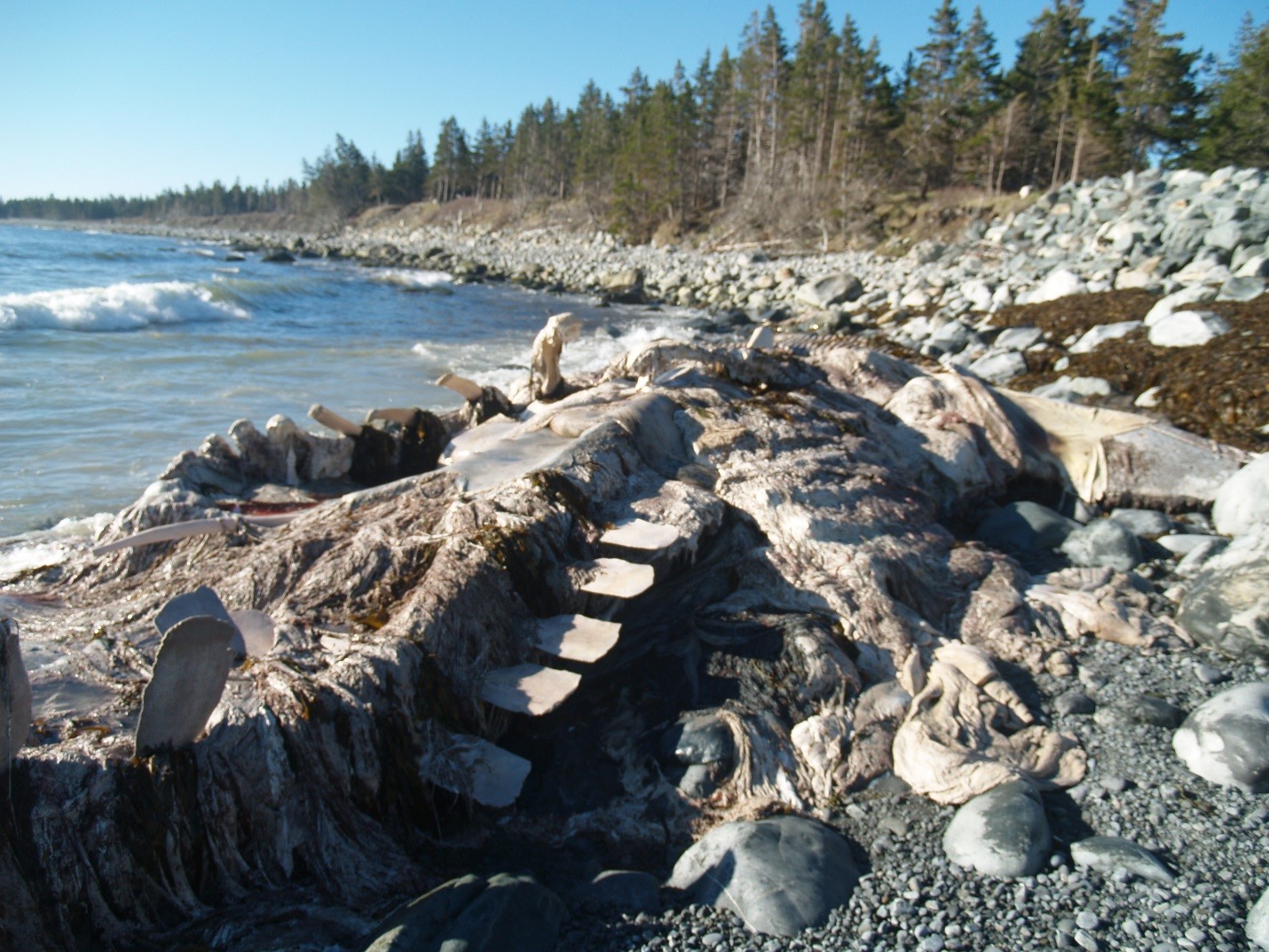 On the second morning of the necropsy it was found that the tide had shifted the Blue Whale carcass.
On the second morning of the necropsy it was found that the tide had shifted the Blue Whale carcass.
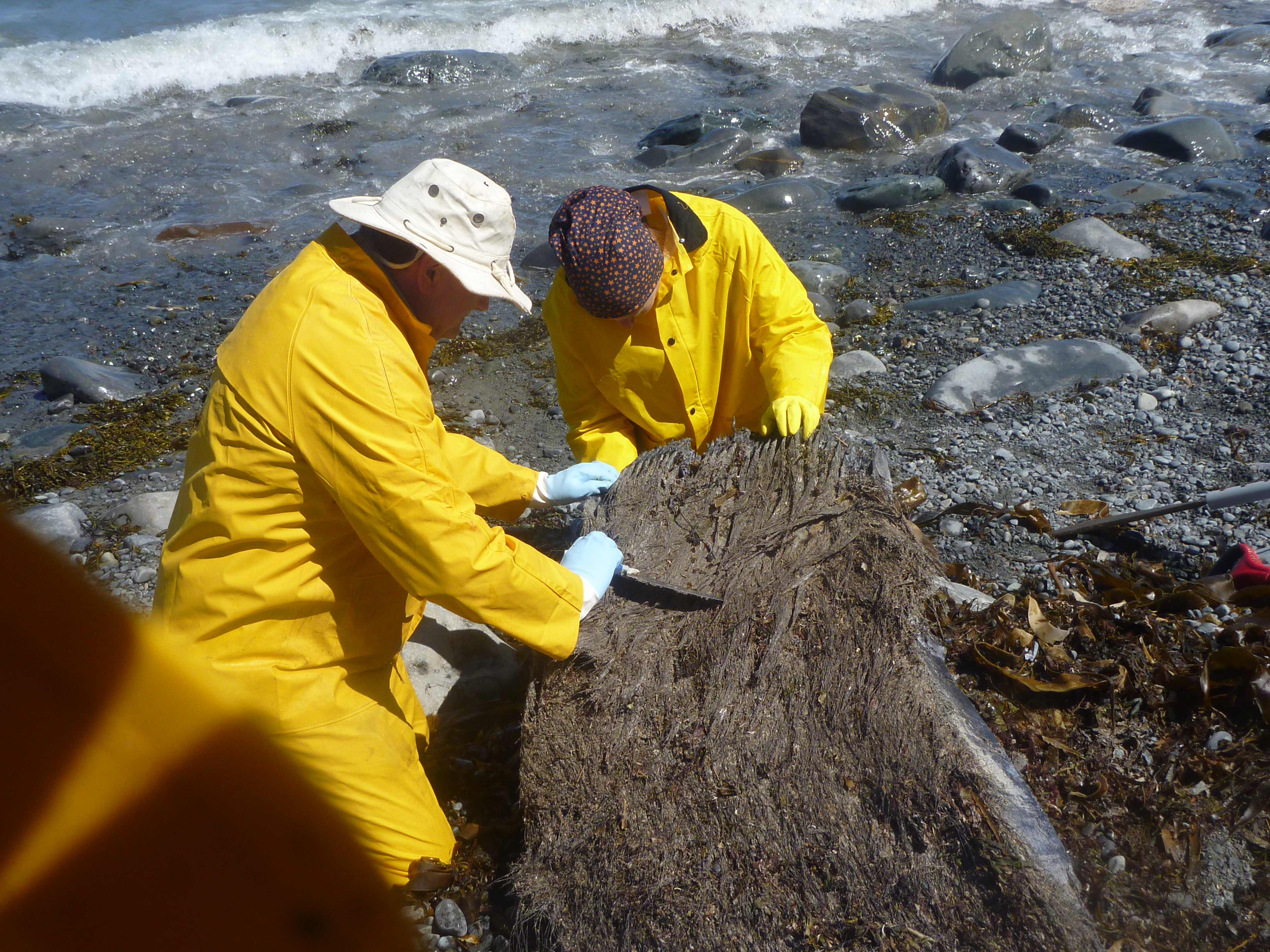 Mary and Ken Sollows collecting Blue Whale baleen for transport to the NB Museum.
Mary and Ken Sollows collecting Blue Whale baleen for transport to the NB Museum.
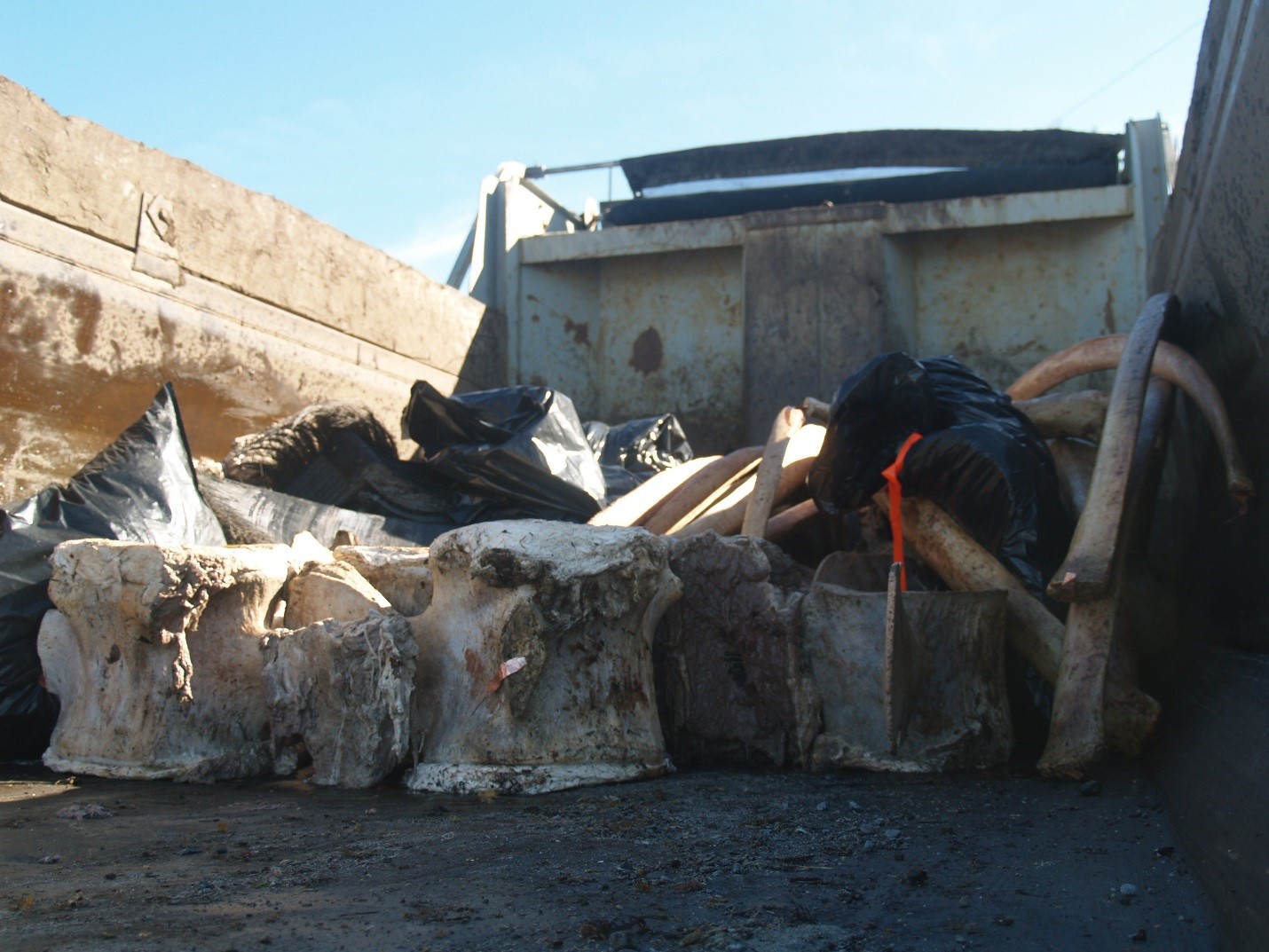 Bones and baleen were transported by dump truck to a site for composting and further cleaning before reconstruction of the skeleton can begin.
Bones and baleen were transported by dump truck to a site for composting and further cleaning before reconstruction of the skeleton can begin.
Madelaine spent much of the second day helping remove the tough, fibrous, tissue that surrounds the bones of the vertebral column that extend into the tail. The narrow part of the tail, referred to as the peduncle, powers the whale’s movement, and is the strongest part of the animal. Surprisingly, the tail flukes contain no bone beyond the few small tail vertebrae; the front flippers however include most of the same bones present in a human hand, testament to the terrestrial ancestory of whales. Whales even have a vestigial pelvic girdle, although their hind legs disappeared long ago. Work on the tail complete, Madelaine then worked with others to separate the various elements of the backbone.
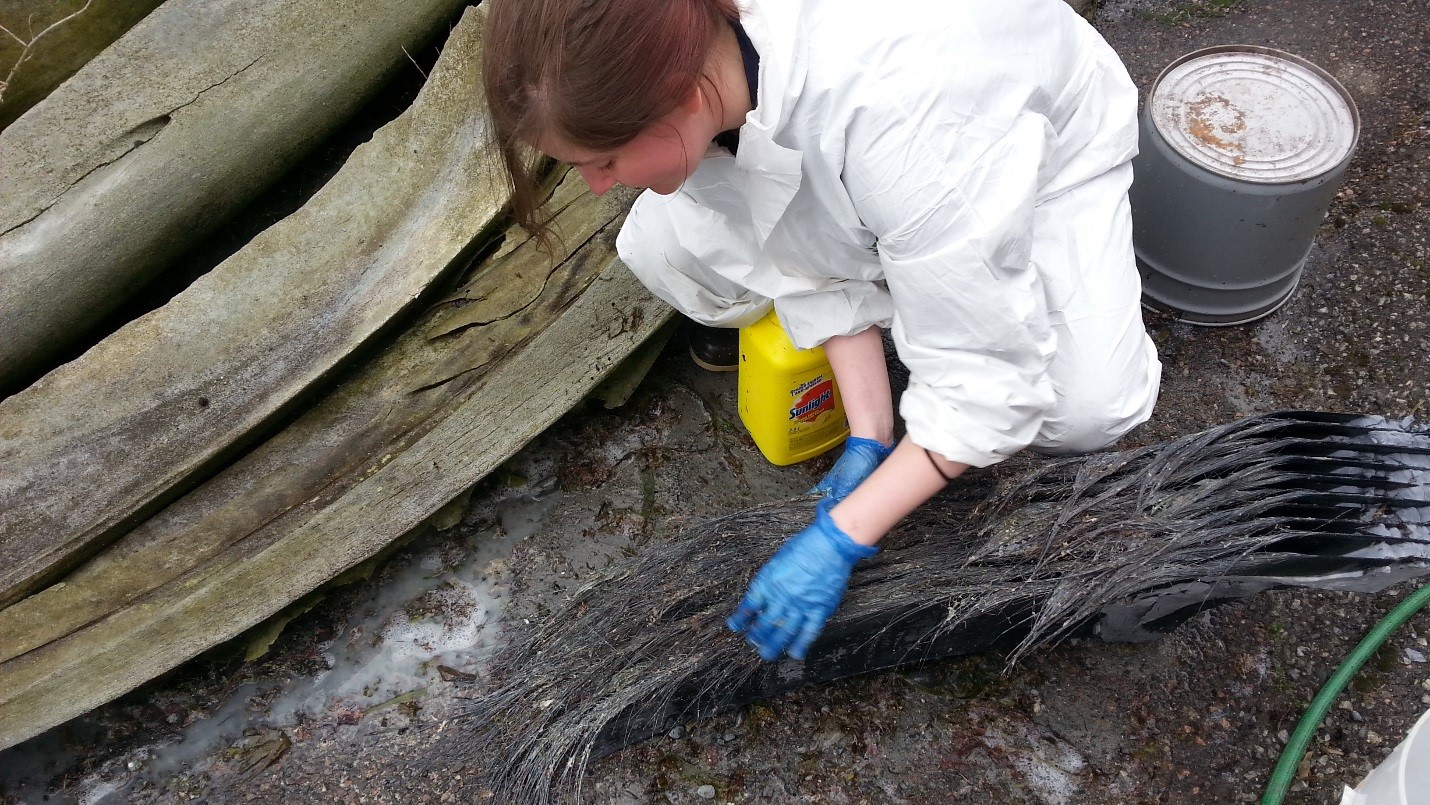 Madelaine Empey cleaning Blue Whale baleen.
Madelaine Empey cleaning Blue Whale baleen.
By day three Andrew Reid, and Drs. Daoust and Harvey-Clark were overseeing completion of the necropsy and preparation of the skeletal remains for trucking to the Truro Agricultural College for composting and cleaning. Meanwhile, Mary and Madelaine collected their prized samples of blubber, muscle, baleen, and a bone for transport to the NBM. Although the NBM includes a good representation of different species of whales this is the first Blue Whale material added to the collection.
Once at the New Brunswick Museum Collections and Research Centre, Madelaine and Mary spent a day preparing the collected samples for the research collection. The baleen section collected, made up of 10 plates joined by gum tissue, was cleaned manually of sand, rocks, seaweed and trimmed of gum tissue before drying. A mild dish detergent was applied using toothbrushes and scrub brushes to the hair-like baleen strands to remove grease. While air drying, the baleen will be monitored for mold and insects and once dry will go through a freeze/thaw/refreeze cycle to ensure any insect pests are dead before being added to the research collection.
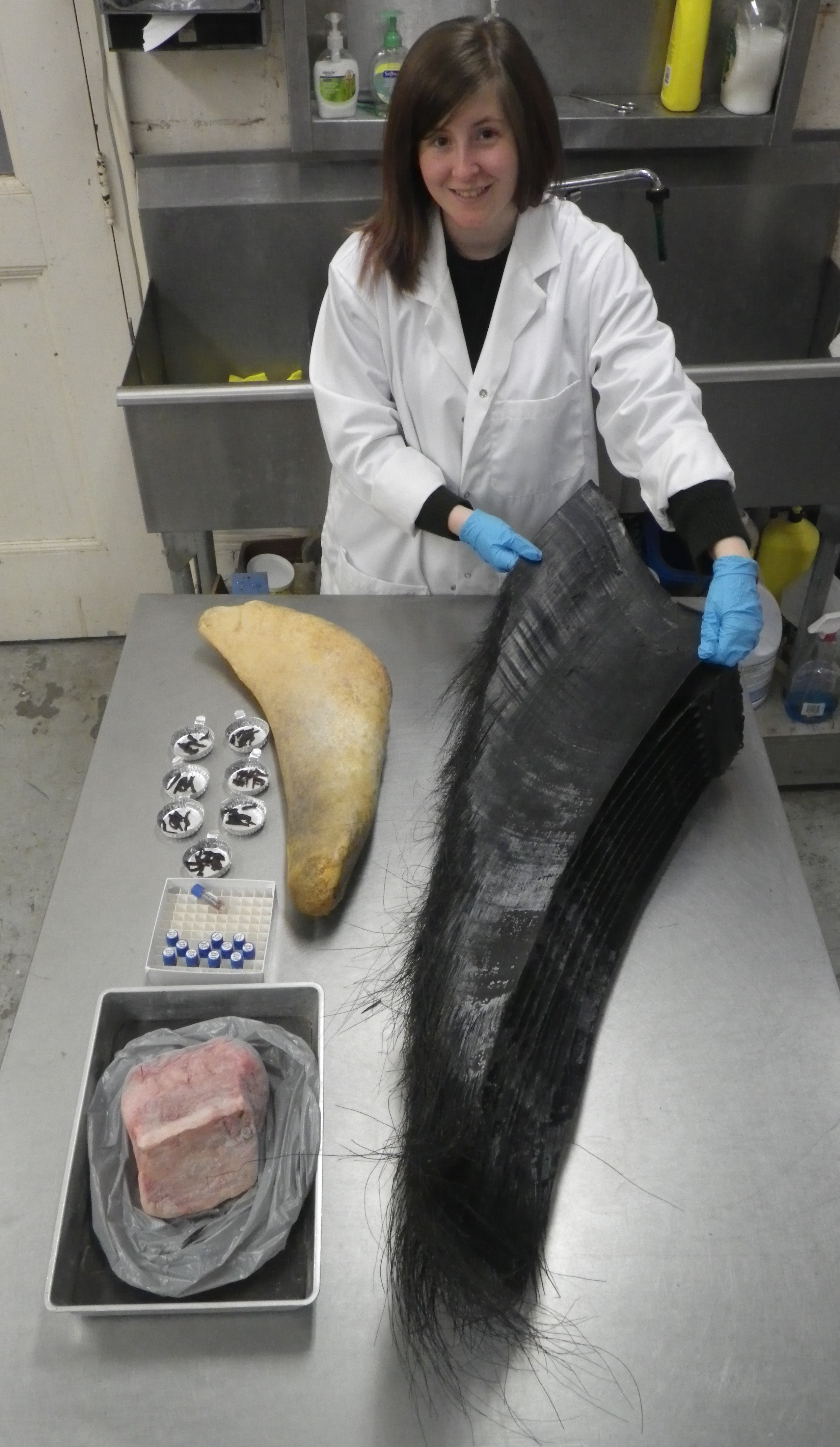 Madelaine Empey lays out the various samples of Blue Whale baleen, bone, tissue, and blubber retrieved following 3 days of effort.
Madelaine Empey lays out the various samples of Blue Whale baleen, bone, tissue, and blubber retrieved following 3 days of effort.
The single bone retained by the NBM was quite clean when collected and it has only been necessary to brush it clean and leave it to dry. Blubber collected will remain frozen as part of the NBM frozen tissue collection, an archive of samples available to researchers as required (one can rarely go out and collect endangered whale tissue just when one has a need for it!). Muscle tissue has been preserved in 95% ethyl alcohol and is stored at -80o C, with additional material dried and stored in desiccant.
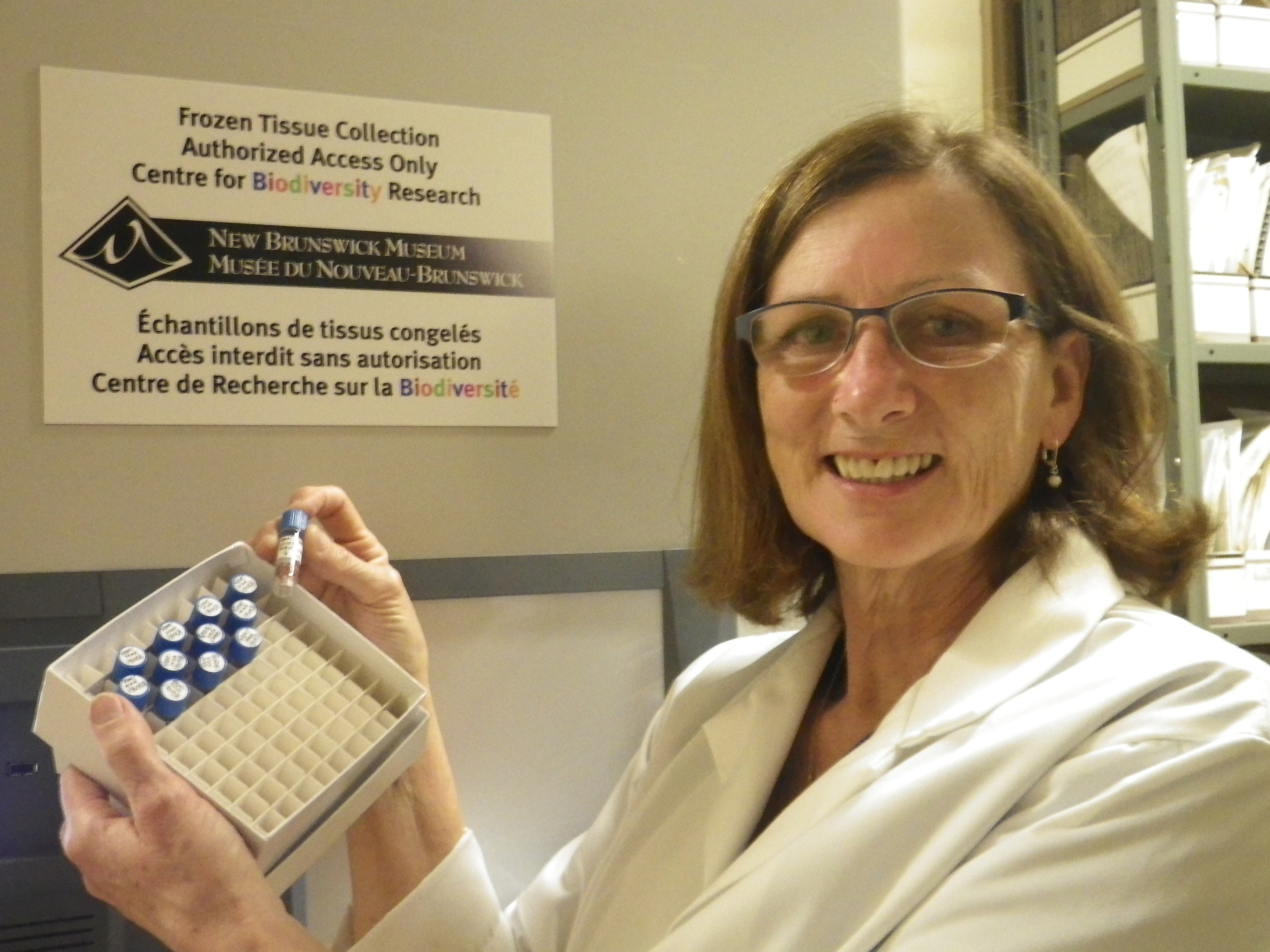 Mary Sollows, with a cryovials of frozen Blue Whale tissue, stands by the NB Museum frozen tissue collection. This specialized freezer can house up to 30,000 samples at -80o C
Mary Sollows, with a cryovials of frozen Blue Whale tissue, stands by the NB Museum frozen tissue collection. This specialized freezer can house up to 30,000 samples at -80o C
Already assigned a NB Museum catalogue (NBM 018058), full data associated with the Blue Whale necropsy will be added to the electronic NB Museum Mammal database. These important specimens will be available for loan to researchers globally, just as the hundreds of thousands of other NBM natural history specimens are, each playing its role in helping to conserve the life forms we share the planet with.
Madelaine A. Empey, Mary C. Sollows and Donald F. McAlpine
Zoology Section, Department of Natural Science, New Brunswick Museum
